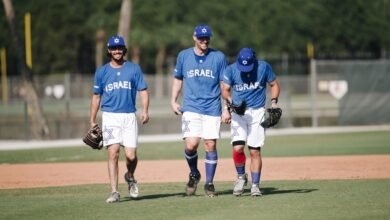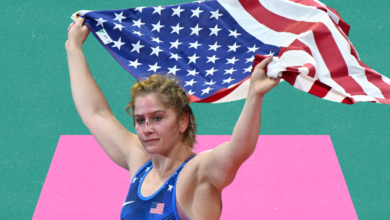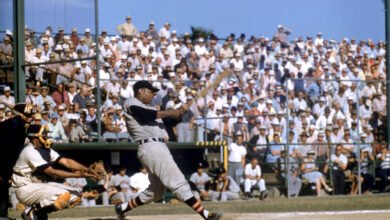That old joke was wrong. The book of Jewish sporting achievements is in fact quite thick… and fascinating.
“In many ways, the development of Jewish sports reflects the realities of Jewish life over the past 120 years,” says Osnat Zur, director of the Iris Smith World Jewish Sports Museum in Ramat Gan’s Kfar Hamaccabiah campus.
The innovative 21st-century museum, inaugurated during the 22nd Maccabiah in 2022, depicts an under-recounted aspect of the development of Jewish identity and Zionism.
“The museum in essence tells not only the story of Jewish sports but of the Jews in general in the 20th century,” says Zur. “We embark on a journey through time, see how the nationalist movements arose around the world, how the first Maccabiah offered a vision, through the disaster of the Holocaust – from which it took decades for Jewish sports to recover – the Munich massacre, and on to October 7.”
A visit to the interactive display, suitable for children and adults alike, puts Jewish sporting achievements in perspective. The 1,500 square-meter museum, designed by Israeli company Breeze Creative, presents the history and heritage of Jewish sports through more than 1,000 rare items, videos, and exhibits.
The museum’s timeline begins in 1890 with the establishment of the first Jewish sports club in Constantinople, Turkey, built around a fencing team. Then Max Nordau’s famous “muscular Jew” speech at the second Zionist Conference in Basel, Switzerland, in 1898 sparked the birth of dozens of Jewish sports clubs throughout Europe, and Jewish sports flourished in the early part of the 20th century.
In terms of achievements, the best was Hakoah Vienna, champions of the Austrian national soccer league in 1924-25 and runners-up in 1921-22. The soccer club’s parent association was the largest sporting organization in the world in its time, numbering more than 5,000 members and offering a wide variety of sporting activities.
Jewish sports – notably fencing and boxing – prospered in Europe until Nazism reared its evil head. The museum’s displays chart the rise in antisemitism in Europe, with Jewish athletes and teams gradually banned from competing. The chronological section devoted to 1933-39 is titled “From Champions to Victims.”
Hitler viewed the 1936 Berlin Olympic Games as a propaganda tool – and the world agreed to his terms, as one of the video displays explains (in your chosen language). Signs at entrances to the Olympic stadium pronounced “No entry for dogs and Jews.”
Then-world champion swimmer Judith Deutch refused to represent Austria, made aliyah instead, and passed away in 2004 after a meaningful life in Israel. It should be noted, however, that other Jews competed in the Olympic Games, and were forced to salute Hitler.
Hakoah Vienna could not survive the Anschluss of March 11-13, 1938, when Nazi Germany annexed neighboring Austria, and the club disbanded in 1941, only to reestablish itself after World War II on a modest scale.
Meanwhile, as more Jewish immigrants poured into pre-state Israel, the local sporting unions Maccabi, Hapoel, and Beitar burgeoned, each with its own political affiliations and patrons.
The Maccabiah is really one man’s idea. Yosef Yekutieli – who later went on to establish the Israel Football Association and Israel Olympic Committee – had the then-maverick vision of holding a “Jewish Olympics” in 1932, and advertised the event by riding his motorcycle throughout Europe. Some 470 competitors turned up for the inaugural Games in Tel Aviv that year. For the second Maccabiah in 1935, some 1,200 athletes competed in a specially erected stadium and swimming pool. Then came the war.
The third Maccabiah in 1952 was a small, sad event that became known as the “revival Maccabiah” – an axiom to be repeated in the 2025 event. Since then, the quadrennial Games have increasingly attracted Jewish (and some non-Jewish) athletes by the thousands, earning the moniker “the second-largest sporting event in the world” (in terms of number of athletes competing) after the Olympics. The Maccabiah is an event with a meaning beyond sports. Among the dignitaries attending the last opening ceremony was US President Joe Biden.
Documenting the past
The need for a museum documenting the rise, fall, and rise again of Jewish sports has become more evident as more Jewish athletes have made their mark on the world stage.
Admittedly, Jews may not have left their mark the way they have, say, on the Nobel Prize, but the list of Jewish sports legends – from the 18th-century father of scientific boxing Daniel Mendoza, through baseball legend Sandy Koufax to multiple gold medalist swimmer Mark Spitz – is richer than generally perceived.
“There had been more talk about establishing the museum over the past decade,” says Zur. “Then came a generous donation from Iris Smith that allowed the project to go ahead.”
Orit Engelberg-Baram was chosen as content curator, a committee of leading sportspeople and sports historians assembled… then the pandemic broke out, and everything stopped. “Ultimately, this actually worked for our good,” says Zur. “Maccabi’s outside activities came to a halt, suddenly freeing up time and resources for this project in a new building under construction on the site of the old museum.”
(The site at Kfar Maccabiah was previously home to a charming, if somewhat aging, corner called The Pierre Gildesgame Maccabi Sports Museum, established in 1982, with an archive and exhibits concerning Judaism, Zionism, and Sports.)
The museum employs English-, Spanish-, and Hebrew-speaking guides. Over 40,000 visitors have passed through so far, mainly Israeli school and pensioner groups and Jewish groups such as Taglit-Birthright and Masa, but also – somewhat surprisingly – many individual non-Jewish tourists. “They want to understand the essence of this country, and sports is part of that,” explains Zur, a former Young Maccabi emissary in the US who is now director of the Maccabiah’s Education Department
“It’s not easy to be a Jewish sportsperson nowadays,” she notes. “Jewish athletes worldwide are increasingly afraid to identify with Israel.”
Even more so their non-Jewish colleagues, at a time when being pro-Palestinian is considered cool.
Within days of October 7, the Maccabi World Union launched its Sportspeakup project, recruiting over 150 leading athletes from around the world – including 15 non-Jewish former NBA basketball players – who recorded social media messages calling for the release of Israeli hostages.
But it wasn’t easy.
“Even though it’s a humanitarian issue not a political one, many of the sportspeople we approached said they were scared to participate. They didn’t want to deal with antisemitic cries from supporters at their games,” explains Zur.
Victory of sports over evil
As Israeli society slowly recovers from the trauma, the museum’s first planned temporary exhibition in July will concentrate on October 7 and sports. “Many sportspeople died that day,” Zur sighs. “There were some heart-wrenching stories, a mixed reaction from the sports world to the event, and more antisemitism in sports.”
The exhibition will recount the story of Israeli sports through the mirror of October 7, focusing on the sporting victories in this most difficult year in the country’s history. Visitors will pass through three tracks that combine the sounds of war and the roar of victory, between the battlefield and the sports field.
The first track describes the reality for Israel’s sporting representatives since October 7, the humiliation and ostracism they face alongside the support and encouragement, and their victories on the sports field. Central to this part of the exhibition will be the historic gold medal of Israeli gymnast Artyom Dolgopiat, won at the World Championships on October 7 at 14:00 Israel time. The second track will memorialize the athletes murdered or wounded on October 7 and the ensuing war, while the third track will tell the story of the missing fans who will never wear their team colors again.
The three tracks will converge to celebrate the victory of sports over evil – the Olympic Games in Paris in July 2024 is due to include the largest Israeli delegation ever, and the 2025 Maccabiah looks like it will be the biggest in history. This exhibition will convey two main messages. To world Jewry: “You are not alone.” And to the world sporting community, “More Than Ever,” with record numbers of participants at the next Olympic Games and Maccabiah. ■
Staying on the map
For decades, participation on the world stage was every Israeli athlete’s dream. Nobody talked about winning – until Maccabi Tel Aviv’s groundbreaking first basketball European Champions Cup in 1977. That game is best remembered for captain Tal Brody’s prophetic after-game exclamation: “We’re on the map and we’re staying on the map – not only in sport, but in everything!” a sound bite that has become a part of Israeli culture.
“Israeli sports in general is continuing to improve, even through this tough period,” says Brody, now a sprightly 80. “In the past few months, we’ve seen international achievements in judo, gymnastics, swimming, wind surfing, taekwondo, and even kick boxing.”
It’s time to stand up and be counted, even in sports that don’t make the big headlines, explains Brody, who made aliyah from Trenton, New Jersey, in 1966, forfeiting a budding NBA career.
Still far from being a sporting powerhouse, Israel is beginning to make its mark on the world stage. Brody puts this down to a cultural shift. “There’s far more physical activity here than in the past. The authorities understand far better the importance of sporting facilities, and now our cities have bicycle lanes, and the parks are full of joggers.
“Israelis are waking up in a sad mood nowadays. Many have lost loved ones or have soldiers on the front line. With all the sorrow, as the day goes on sports gives them spirit and pride. Our athletes have to go out to the world where people don’t understand the situation, where they hear false narratives and there’s an antisemitic atmosphere. But the people of Israel believe in the country, and our sportsmen also feel this. Even as the war rages, our athletes are taking top places in competitions in places like Qatar and Tashkent, proudly competing with the Star of David on their uniforms.”




